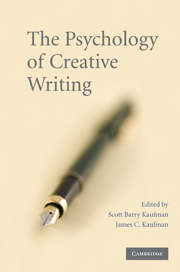Book contents
- Frontmatter
- Contents
- Contributors
- Foreword
- Preface
- Acknowledgments
- PART I THE WRITER
- PART II THE TEXT
- PART III THE PROCESS
- PART IV THE DEVELOPMENT
- 13 Writing in Flow
- 14 Writer's Block and Blocked Writers: Using Natural Imagery to Enhance Creativity
- 15 Pretend Play, Emotional Processes, and Developing Narratives
- 16 The Healing Powers of Expressive Writing
- PART V THE EDUCATION
- Index
- References
13 - Writing in Flow
Published online by Cambridge University Press: 25 January 2010
- Frontmatter
- Contents
- Contributors
- Foreword
- Preface
- Acknowledgments
- PART I THE WRITER
- PART II THE TEXT
- PART III THE PROCESS
- PART IV THE DEVELOPMENT
- 13 Writing in Flow
- 14 Writer's Block and Blocked Writers: Using Natural Imagery to Enhance Creativity
- 15 Pretend Play, Emotional Processes, and Developing Narratives
- 16 The Healing Powers of Expressive Writing
- PART V THE EDUCATION
- Index
- References
Summary
It is very gratifying for a researcher/practitioner to discover that her personal experience bears out the results of her own previous study. I enjoyed this fortunate circumstance recently when I wrote my first novel some years after completing a dissertation and later writing a popular trade book about successful writers and their writing processes (Perry, 1996, 1999).
My writing research consisted of interviews with a convenience sample of 76 regularly publishing writers (40 novelists and 36 poets; 43 males, 33 females). Participants included both best-selling novelists such as Jonathan and Faye Kellerman, Sue Grafton, Michael Connelly, T. Coraghessan Boyle, and Ursula LeGuin, and Pulitzer Prize, MacArthur Foundation Award, and American Book Award winning literary authors and poets such as Jane Smiley, Robert Olen Butler, Donald Hall, Octavia Butler, Philip Levine, and Mark Strand. (All attributed but uncited quotes in this article are from interviews I personally conducted [Perry, 1996, 1999].) I also read hundreds of accounts of and interviews with writers and have continued to do so.
So many of the creative writers with whom I spoke enjoyed writing so much that I decided to try it myself. I had been an independent writer of nonfiction books and articles for magazines and newspapers for the previous two decades. I wondered whether it would be possible for a writer who had until then been so scrupulous about truthfulness to make things up.
- Type
- Chapter
- Information
- The Psychology of Creative Writing , pp. 213 - 224Publisher: Cambridge University PressPrint publication year: 2009
References
- 7
- Cited by

